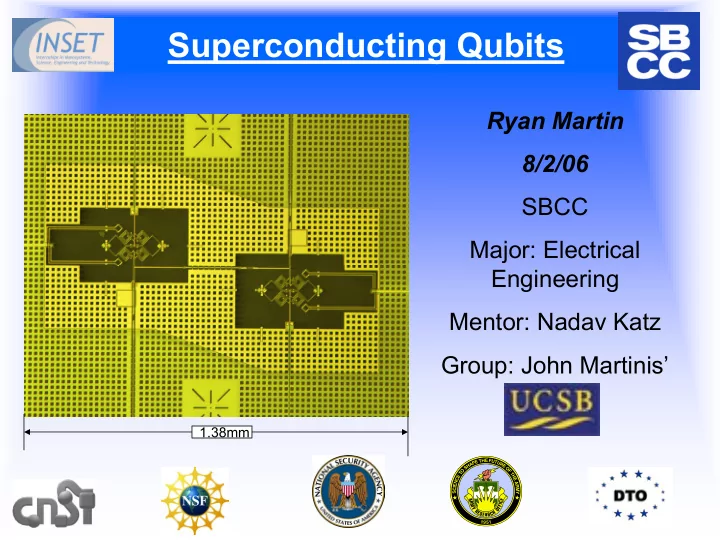

Superconducting Qubits Ryan Martin 8/2/06 SBCC Major: Electrical Engineering Mentor: Nadav Katz Group: John Martinis’ 1.38mm
Superconducting Qubits are very scalable! so….. We could use them to build a: Quantum Computer With a quantum computer, you can: • Run much faster simulations • Crack tough codes in real time • Impress people at parties Quantum Computation is known to be an exponential speed increase over classical computation!
Qubit?!? Qubit (kyü-bit) Qubit = Quantum bit • A classical computer bit has two states: on or off • A qubit is governed by Quantum Mechanics – A qubit can be in a of two states
The Quantum World • Superposition means many places at once…. and then we measure it… http://www.gly.fsu.edu/~salters/G www.ktf-split.hr LY1000/6_Minerals/Slide9.jpg
What Superposition Can Do For You! + = ψ A 0 B 1 ψ …Where is the state you’re in • In a Classical bit, A and B can only be 0 or 1 • In a Quantum Bit, The only governing rule is: 2 2 + = A B 1 2 A Where is the probability of your bit measuring in + 0 the state 2 = B And is the probability of measuring your bit in 1 the state
The Quantum World with Electric Circuits N. Katz,1 M. Ansmann,1 Radoslaw C. Bialczak,1 Erik Lucero,1 R. McDermott,1 Matthew Neeley,1 Matthias Steffen,1 E. M. Weig,1 A. N. Cleland,1 John M. Martinis,1* A. N. Korotkov2 . Coherent State Evolution in a Superconducting Qubit from Partial-Collapse Measurement . Science. 9 June, 2006. http://www.sciencemag.org/cgi/content/full/312/5779/1498?ijkey=lRLKuFaYL68Q.&keytype=ref&siteid=sci.
Controlling Our Qubit! High Low Problems arise when Frequency Frequency sending electric pulses from room temperature transmission lines to virtually no impedance superconducting lines! Ground Our Solution…
Schematic Low Frequency High Frequency Line Line 50 Ω Transmission Lines Bias-T in Dashed Box Inductor Impedance of Line at Qubit << 50 Ω Qubit
Our “Bias-T” Connection High Frequency Line to Qubit Connection Zoom of Inductor coils and resistors Low Frequency Line
New Possibilities
Acknowledgements INSET CNSI John Martinis Group: Professor: John Martinis National Science Foundation Mentor: Nadav Katz Army Research Office Markus Ansmann National Security Agency Robert McDermot Disruptive Technology Office Radek Bialzcak Eric Lucero Matthew Neeley Sam Rosenthal
My Role: • Fabrication and Analysis of microwave components • Experimental setup and analysis using Adiabatic Demagnetization Refrigerator (ADR) • Understanding and Application of Theory
PV = nRT so if you ↑ V = ↓ T
Josephson Junction Two superconductors separated by a thin dielectric
Recommend
More recommend